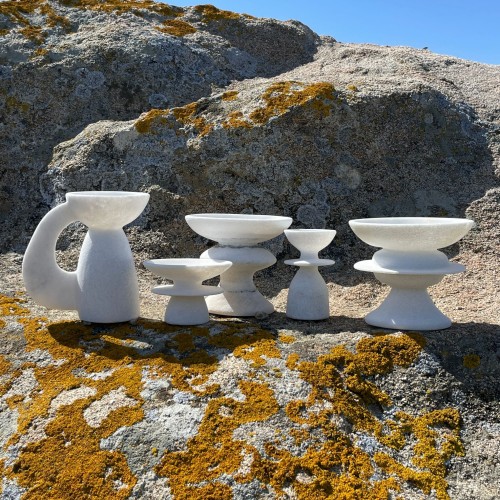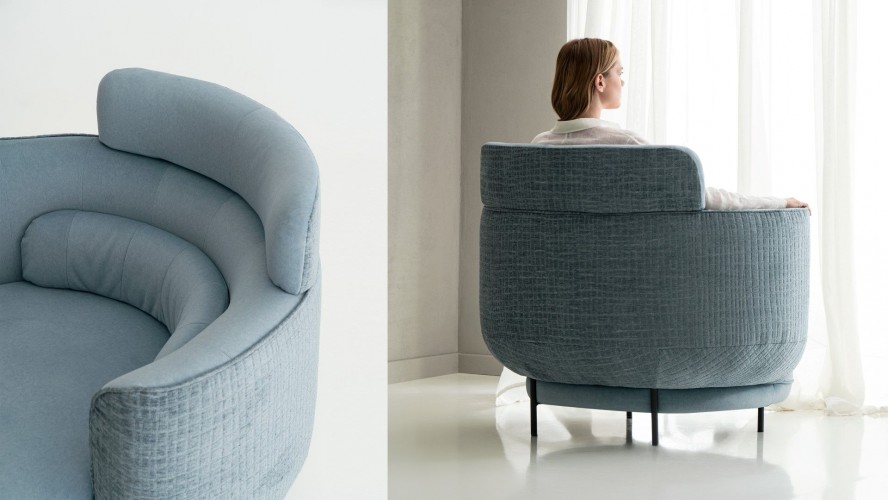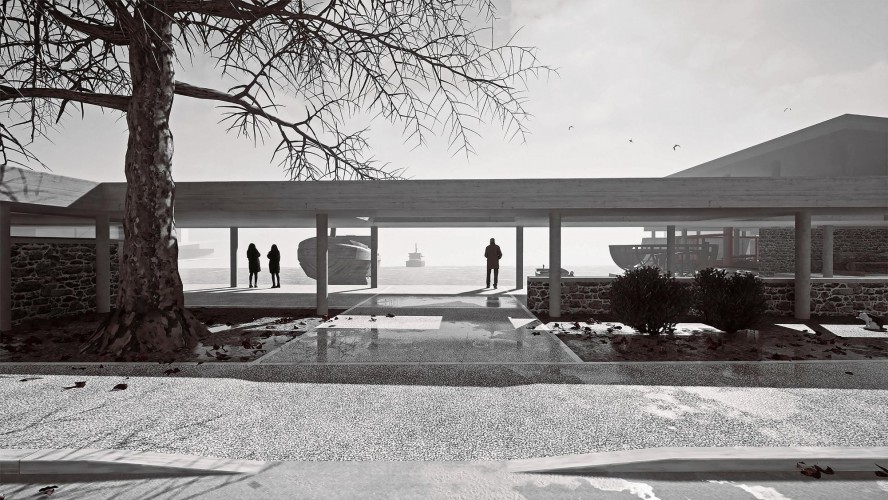Ο Σταύρος Περάκης πλάθει design με πηλό
DS.WRITER:
Vasilis Xifaras
Κεντρική εικόνα: Naked Vessels, 2017, Α’ Βραβείο στον 55ο Πανελλήνιο Διαγωνισμό Κεραμικής
Οι ρίζες του Σταύρου Περάκη βρίσκονται στο κρητικό χώμα, αλλά ο ίδιος πλέον ζει και εργάζεται στην Αθήνα. Έχοντας έρθει σε επαφή με την κεραμική το 2011, και αφού συν-δημιούργησε τον αυτοδιαχειριζόμενο χώρο τέχνης Da στην πόλη του Ηρακλείου το 2014, βραβεύτηκε στον 55o Πανελλήνιο Διαγωνισμό Κεραμικής το 2017, και πλέον πλάθει έργα τέχνης και λειτουργικά αντικείμενα για χώρους εστίασης, ξενοδοχεία, κατοικίες αλλά και γκαλερί και εκθέσεις. Οι δημιουργίες του διακρίνονται από κομψότητα, απλότητα και κίνηση, χαρακτηριστικά που δίνονται στον κατά τα άλλα στιβαρό πηλό με μεγάλη δεξιοτεχνία.
Περισσότερα για το έργο του θα μας πει όμως ο ίδιος ο Σταύρος Περάκης.
.jpg)
Fluid Vases, 2021, για το MON COIN Studio. Φωτ: Bill Politis
Εκτός από τη ροϊκότητα και το σμίλευμα των καμπυλών, στη φόρμα των γλυπτών σας αποδίδετε γραμμικές τομές που διαταράσσουν την οργανικότητα. Πώς προέκυψε αυτό το λεξιλόγιο, και πώς καταφέρνετε να διατηρείτε τη λειτουργικότητα των αντικειμένων;
Ανέκαθεν θεωρούσα τον εαυτό μου βαθιά επηρεασμένο από τον τομέα της αρχιτεκτονικής, που ήταν και το αντικείμενο των σπουδών μου. Ήδη από τα σχολικά μου χρόνια έμαθα να διαβάζω και να μιλάω τη γλώσσα του σχεδίου. Μια γλώσσα που με γοητεύει ακόμα και σήμερα. Το σημείο και η γραμμή είναι οι βασικές αρχές της γλώσσας αυτής και θα παραμείνουν αναπόσπαστο κομμάτι της δουλειάς μου. Σε ό,τι αφορά την κεραμική, ο τρόπος που λειτουργώ τις περισσότερες φορές δεν περιλαμβάνει καθόλου τον σχεδιασμό. Ο σχεδιασμός προκύπτει ξεκινώντας από μια ποσότητα πηλού και μια ιδέα του αντικειμένου, π.χ. βάζο. Όλες οι αποφάσεις λαμβάνονται τη στιγμή της κατασκευής, σαν μια μικρή γέννα που μέχρι την ολοκλήρωσή της δεν ξέρεις τι αποτέλεσμα θα έχει. Είναι μια συνδημιουργία με το υλικό στον συγκεκριμένο χρόνο και χώρο. Πολλές φορές το αποτέλεσμα δεν είναι ικανοποιητικό, άλλες πάλι είναι μια έκπληξη που έρχεται στο παρόν. Ο πηλός από τη φύση του έχει μια οργανικότητα. Κινείται, μεταλλάσσεται και συρρικνώνεται. Είναι ένας υπάκουος φίλος, με τις ιδιαιτερότητές του αλλά και τους περιορισμούς του.
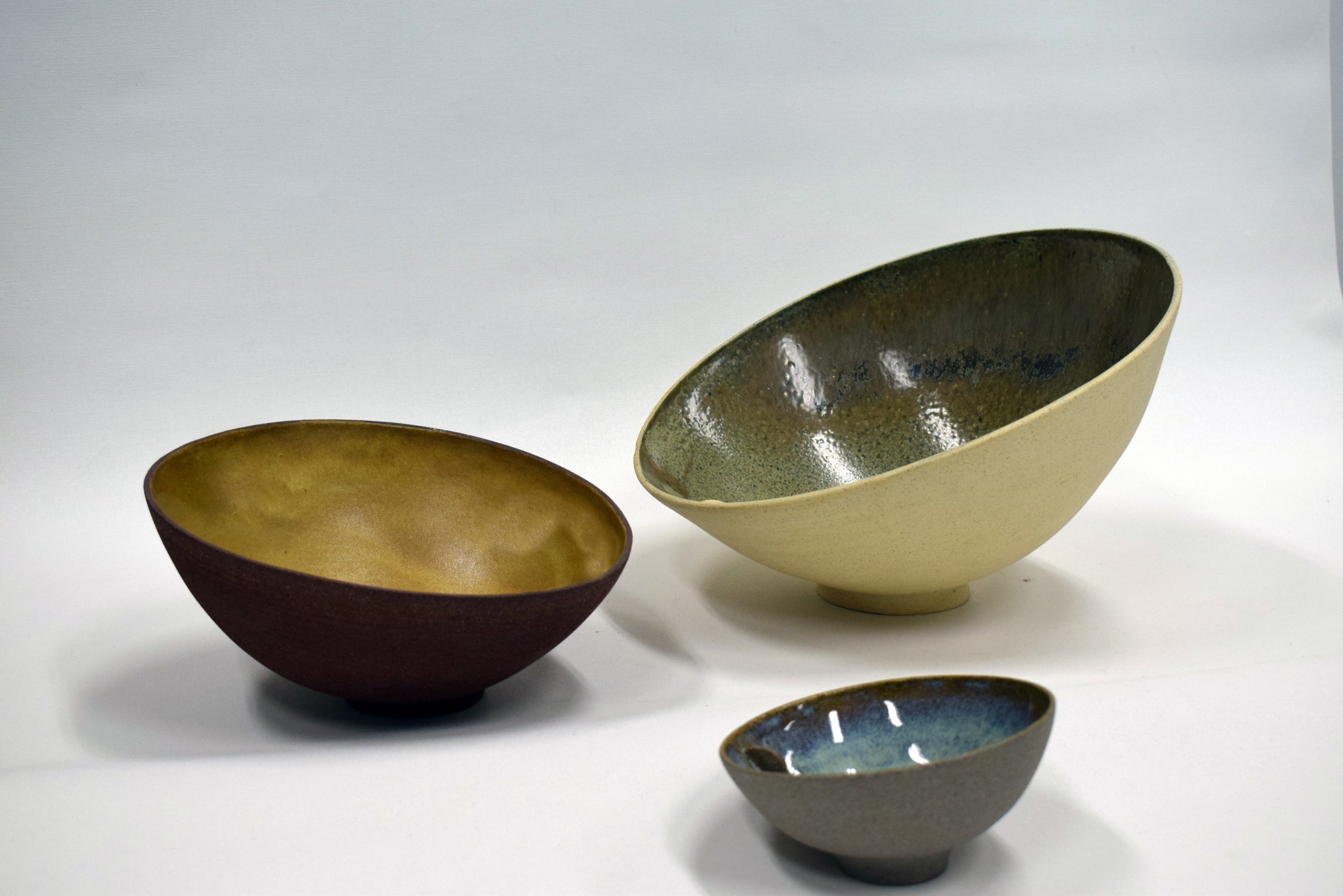
Ariadne's Thread, 2017, έκθεση “Μεταμόρφωσις” στην Eleni Marneri Gallery
Η επίδραση από το χρώμα, τη γεωμετρία και την υφή της κρητικής γης, αλλά και από την τέχνη του μινωικού πολιτισμού, είναι έντονη στα δοχεία Ariadne, Ariadne's thread και Minotaur. Από ποιες πηγές αντλείτε έμπνευση;
Η συγκεκριμένη σειρά παρουσιάστηκε το 2019 στην Eleni Marneri Gallery. Ήταν μια ομαδική έκθεση που διοργανώθηκε από τη σχολή «Κεραμικές Μορφές», όπου ήμουν ένας από τους διδάσκοντες εκείνη την περίοδο. Ο σκοπός της έκθεσης ήταν εμπορικός με τουριστικό χαρακτήρα. Έτσι οδηγήθηκα στο να παρουσιάσω ένα κομμάτι της ιστορίας του μινωικού πολιτισμού, μέσω τριών κεραμικών σκευών σε τρεις διαφορετικούς χρωματισμούς. Η έκθεση είχε μεγάλη επιτυχία και πήρε πολύ καλές κριτικές. Έμπνευση, πέρα από την ιστορία, αντλώ από τη φύση, την αρχιτεκτονική, τον κινηματογράφο, τις τέχνες γενικότερα. Αλλά και μέσα από την καθημερινότητα, βάσει των οικονομικών και κοινωνικοπολιτικών συνθηκών που βιώνουμε όλοι μας.
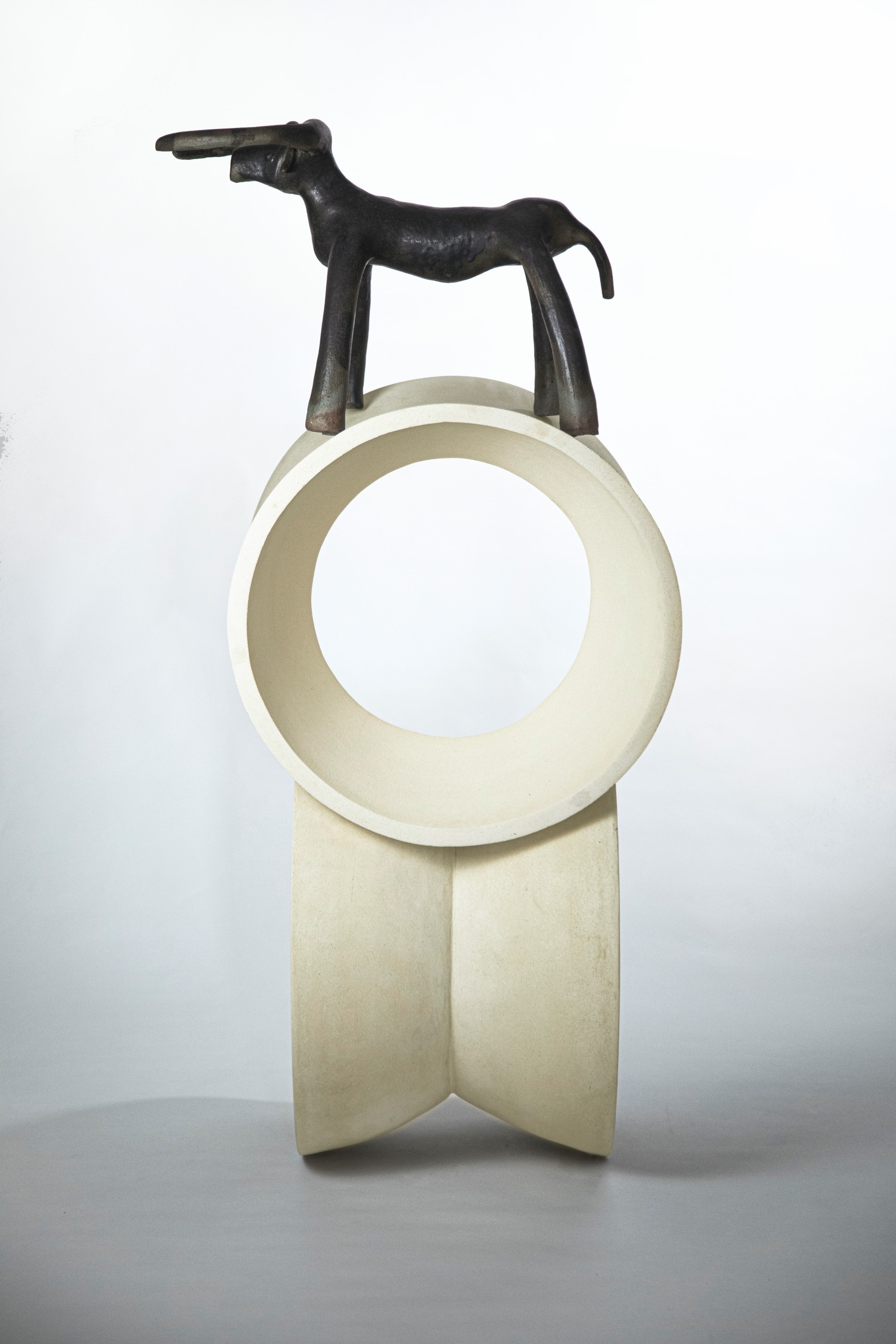
“Μπροστά σου - προσφορά στον Δία”, 2021, 6η Έκθεση Κεραμικής στο Αρχαιολογικό Μουσείο Ολυμπίας από το Group Ceramists Traces. Φωτ: Bill Politis
Έχετε δημιουργήσει φωτιστικά, τραπεζαρίες και άλλα αντικείμενα, με βάση την πορσελάνη και τον πηλό, που ξεφεύγουν από τη μικρή κλίμακα. Ποια θεωρείτε ότι είναι τα πλεονεκτήματα της χρήσης αυτών των υλικών, έναντι άλλων διαδεδομένων, όπως το ξύλο, το μέταλλο ή το γυαλί;
Δεν θεωρώ ότι κάποιο υλικό υπερτερεί κάποιου άλλου. Τα διαφορετικά υλικά εκπροσωπούν τις διαφορετικές προσωπικότητες που βρίσκουν τρόπους να εκφράζονται μέσα από αυτά. Κάποιος designer μπορεί και είναι σε θέση να τα συνδυάσει, μόνο που θα χρειαστεί τεχνίτες να του κατασκευάσουν τα επιμέρους μέρη. Τεχνίτες με διαφορετικούς εξοπλισμούς, που ξέρουν να δημιουργούν το επιθυμητό αποτέλεσμα. Είναι λεπτές οι έννοιες τεχνίτης, καλλιτέχνης, designer. Εμένα ο πηλός μού έχει δώσει την ευκαιρία να κινούμαι ανάμεσα και στις τρεις κατά καιρούς. Η μεγάλη κλίμακα είναι μια πρόκληση στην κεραμική, αν σκεφτείς ότι πριν μπει στο καμίνι έχεις να διαχειριστείς μόνο ξερό χώμα, πρέπει να ξέρεις να το πιάσεις, να το σηκώσεις, για να μην πάει ο κόπος σου χαμένος. Η κεραμική είναι άπειρη, δεν μπορεί κανείς να την κατακτήσει ολοκληρωτικά. Είναι η δημιουργία μέσω των στοιχείων της φύσης (νερό, φωτιά, γη). Και λέγοντας γη, δεν εννοώ μόνο τον πηλό, αλλά και μια σειρά χημικών στοιχείων του περιοδικού πίνακα, όπως το πυρίτιο, το ασβέστιο, τον σίδηρο, το τιτάνιο και άλλα. Είναι υλικά που χρησιμοποιούμε για την υαλοποίηση ενός κεραμικού σώματος, και σε θερμοκρασίες μεταξύ 1000°C και 1300°C μεταλλάσσουν τις χημικές τους ιδιότητες και δίνουν τα τελικά αποτελέσματα.
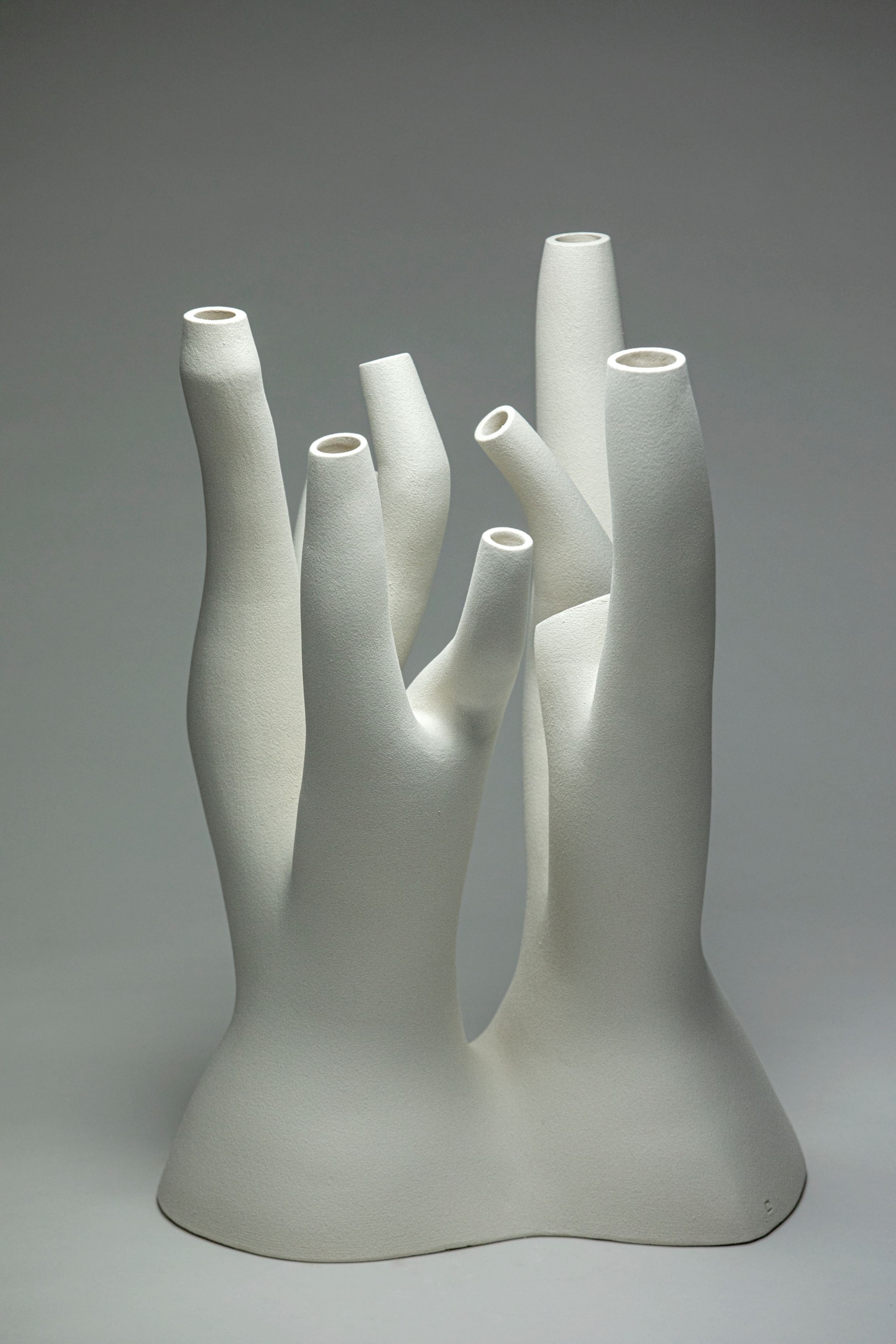
Roots, 2022, 7η Έκθεση Κεραμικής στο Αρχαιολογικό Μουσείο Ηρακλείου από το Group Ceramists Traces. Φωτ: Bill Politis
Στο πλαίσιο αυτής της ενασχόλησης με το interior design, έχετε συνεργαστεί με brands και αρχιτεκτονικά γραφεία όπως το Block 722. Πείτε μας περισσότερα.
Τα τελευταία δύο χρόνια είμαι μέλος της ομάδας Unprocessed Realities. Μαζί έχουμε μια πολύ καλή συνεργασία με το Block 722. Έτσι, μας έχει δοθεί η ευκαιρία να σχεδιάσουμε και να κατασκευάσουμε μοναδικά κεραμικά σε κάποια project τους. Κομοδίνα, κονσόλες, απλίκες, αλλά και κεραμικά μικρότερης κλίμακας, όπως πιατέλες, διακοσμητικά εσωτερικού και εξωτερικού χώρου, είναι κάποια από τα αντικείμενα που έχουμε συνδημιουργήσει. Προσωπικά απολαμβάνω ιδιαίτερα τέτοιου είδους συνεργασίες, γιατί με εξελίσσουν προσωπικά αλλά και επαγγελματικά. Είναι πολύ ωραίο που η αισθητική τού γραφείου έχει ταιριάξει με την αισθητική της ομάδας, με το αποτέλεσμα να μας δικαιώνει όλους.
Μέσα από τη συμμετοχή σας στην έκθεση Forma | 1st Athens Creators Showcase at Romantso, είχατε την ευκαιρία να δείτε έργα κι άλλων δημιουργών και να συνομιλήσετε με το κοινό. Σε τι φάση θεωρείτε ότι βρίσκεται το ελληνικό χειροποίητο design;
Η Ελλάδα έχει στο δυναμικό της έναν μεγάλο αριθμό ταλαντούχων και δημιουργικών ανθρώπων, που συνήθως κινούνται μόνοι τους, χωρίς πολλές ευκαιρίες για δημιουργικό διάλογο και ανταλλαγή ιδεών. Η συγκεκριμένη έκθεση ήταν μια καλή ευκαιρία για όλους μας να επικοινωνήσουμε τη δουλειά μας, να μοιραστούμε τις ανησυχίες μας μεταξύ δημιουργών, αλλά και με το κοινό. Η έκθεση είχε πολύ μεγάλη προσέλευση, αλλά δυστυχώς κράτησε μια μόνο μέρα λόγω της πρώτης καραντίνας τον Μάρτιο του 2020. Ευελπιστώ ότι στο μέλλον θα υπάρξουν και άλλες τέτοιες πρωτοβουλίες, που έχουν σαν σκοπό την προώθηση του ελληνικού design που κάνει τα πρώτα του βήματα και είναι πολλά υποσχόμενο. Πιστεύω ότι σύντομα θα δούμε εντυπωσιακά πράγματα από τους Έλληνες σχεδιαστές.
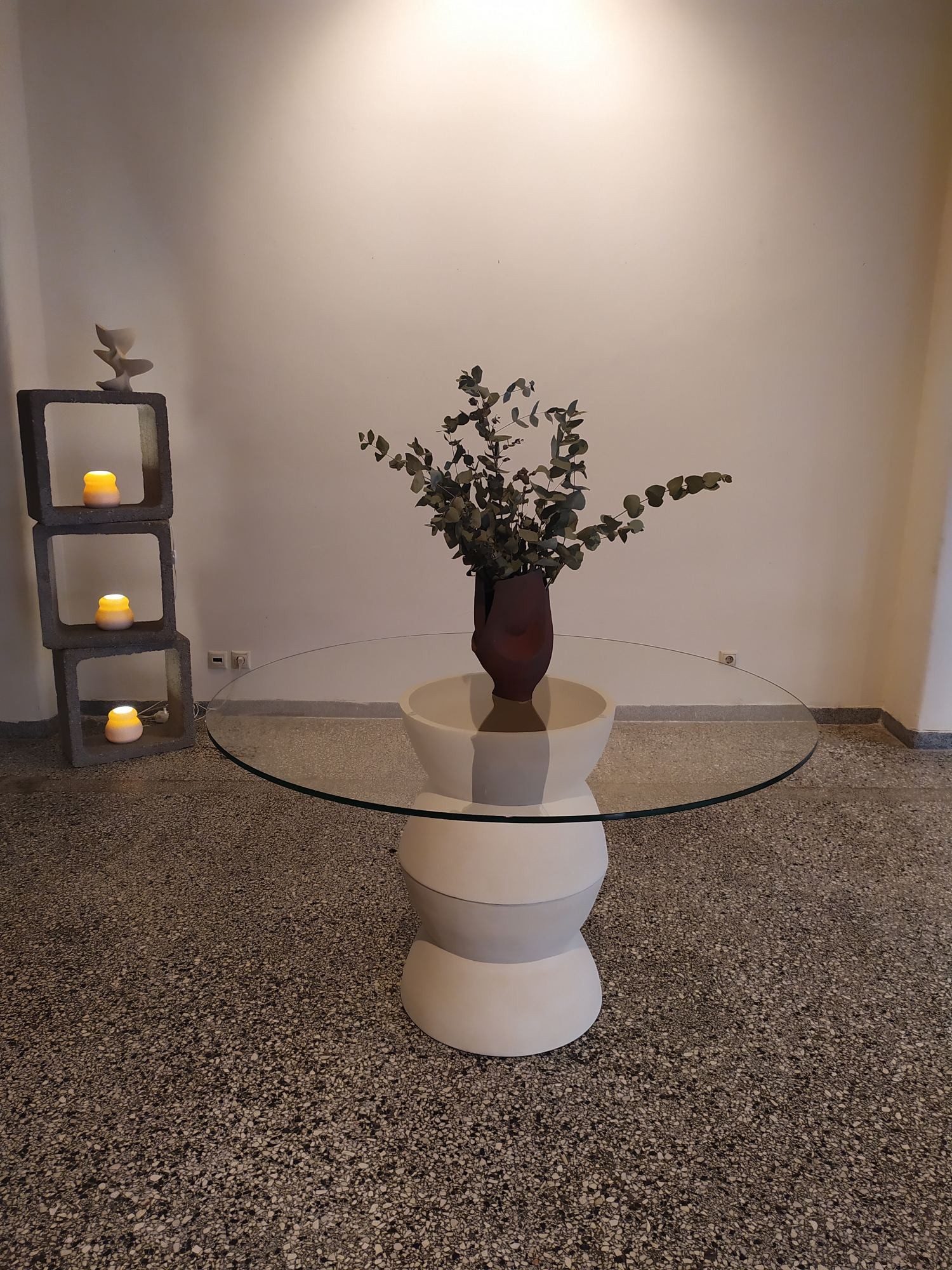
Τραπεζαρία Ροτόντα, 2020, έκθεση Forma | 1st Athens Creators Showcase at Romantso
Τι επιφυλάσσει το μέλλον για εσάς και τα δημιουργικά σας σχέδια;
Ποιος ξέρει; Ελπίζω οι συνθήκες να συνεχίσουν να μου επιτρέπουν να παραδίδω μαθήματα κεραμικής. Είναι κάτι που αγαπώ ιδιαίτερα, γιατί μου δίνει τη δυνατότητα να γνωρίζω ενδιαφέροντες ανθρώπους και να τους μεταδίδω το μικρόβιο της κεραμικής. Θα ήθελα να έχω περισσότερες και όμορφες συνεργασίες, όπως αυτή με τους Unprocessed Realities και τους Block 722, γιατί με εξελίσσουν με ποικίλους τρόπους. Θα ήθελα να βρίσκω στον δρόμο μου δασκάλους να με εμπνέουν και να με ωθούν στο να γίνομαι καλύτερος σε ό,τι αφορά την κεραμική αλλά και σαν άνθρωπος.
Ευχαριστούμε πολύ τον Σταύρο Περάκη για τις ενδιαφέρουσες απαντήσεις του.




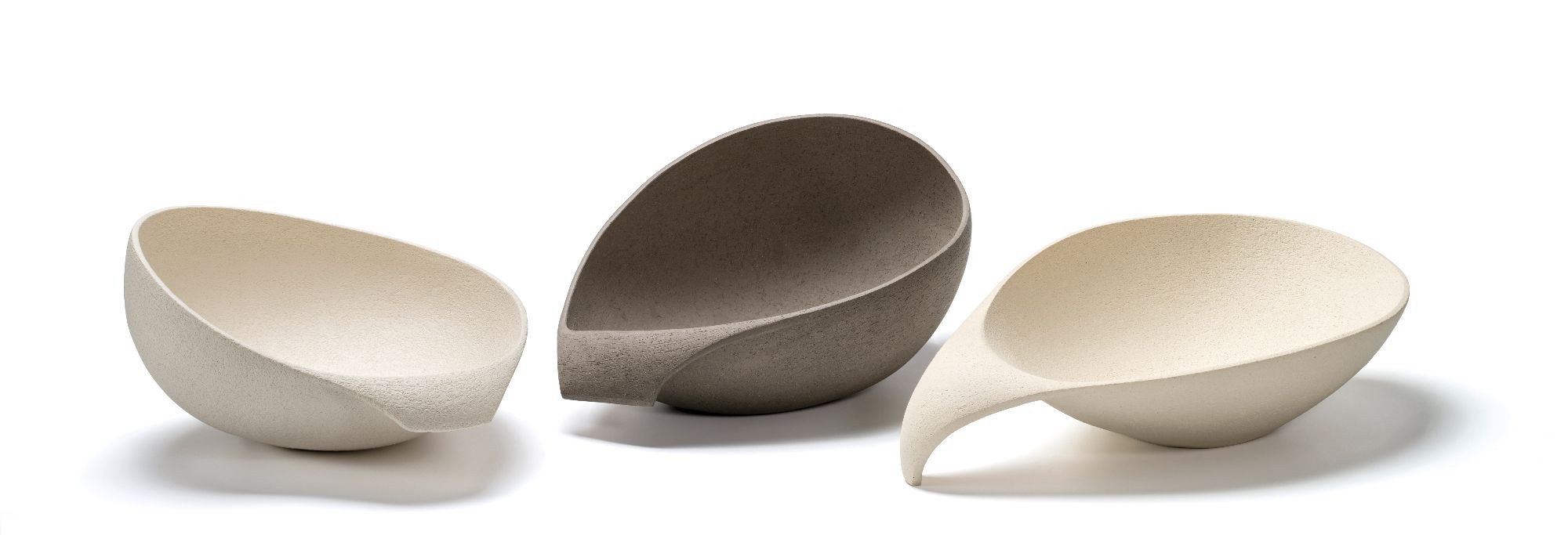
.jpg)
